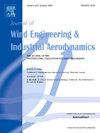隧道中列车滑流的数值计算:CFD数据的随机分析
IF 4.9
2区 工程技术
Q1 ENGINEERING, CIVIL
Journal of Wind Engineering and Industrial Aerodynamics
Pub Date : 2025-07-03
DOI:10.1016/j.jweia.2025.106130
引用次数: 0
摘要
列车滑流是指列车运行时产生的动态气流,在隧道等密闭环境中存在较大的安全隐患。虽然许多研究都集中在露天的滑流效应上,但由于模拟这些复杂的空气动力学条件的挑战,对隧道的研究受到限制。本研究旨在通过验证基于URANS的CFD模型来解决这些挑战,并将其与实验数据进行比较。引入了一种新的数值统计方法,可以使用扩展的隧道配置对滑流现象进行稳健的表征,允许从一次模拟中收集多个独立的速度剖面。研究结果强调了短隧道和长隧道滑流特性的差异,强调了隧道长度对活塞风和尾迹发展的影响。通过统计比较,包括集合均值、标准差和峰值分布,该研究表明,多探针方法提供了滑流行为的稳健和详细的表示。该方法为描述滑流统计提供了一个通用的、可复制的框架,在缺乏实验数据的早期列车和隧道设计阶段特别有价值,并在列车认证过程中显示出有希望的潜力。本文章由计算机程序翻译,如有差异,请以英文原文为准。
Numerical assessment of train slipstream in tunnels: Stochastic analysis from CFD data
The train slipstream, referring to the dynamic airflow induced by moving trains, presents significant safety risks in confined environments like tunnels. While much research has focused on slipstream effects in open air, studies in tunnels are limited due to the challenges of simulating these complex aerodynamic conditions. This study aims to address these challenges by validating a CFD model based on URANS for train slipstream analysis in tunnels, comparing it against experimental data. A novel numerical statistical approach is introduced, enabling the robust characterization of slipstream phenomena using extended tunnel configurations, allowing the collection of multiple independent velocity profiles from a single simulation. The results highlight the differences in slipstream behavior between short and extended tunnels, emphasizing the impact of tunnel length on piston wind and wake development. By focusing on statistical comparisons, including ensemble mean, standard deviation, and peak distribution, the study demonstrates that the multiple-probe approach offers a robust and detailed representation of slipstream behavior. This methodology provides a general and replicable framework for characterizing slipstream flow statistics, proving especially valuable during early train and tunnel design stages where experimental data are lacking, and showing promising potential in the context of train homologation processes.
求助全文
通过发布文献求助,成功后即可免费获取论文全文。
去求助
来源期刊
CiteScore
8.90
自引率
22.90%
发文量
306
审稿时长
4.4 months
期刊介绍:
The objective of the journal is to provide a means for the publication and interchange of information, on an international basis, on all those aspects of wind engineering that are included in the activities of the International Association for Wind Engineering http://www.iawe.org/. These are: social and economic impact of wind effects; wind characteristics and structure, local wind environments, wind loads and structural response, diffusion, pollutant dispersion and matter transport, wind effects on building heat loss and ventilation, wind effects on transport systems, aerodynamic aspects of wind energy generation, and codification of wind effects.
Papers on these subjects describing full-scale measurements, wind-tunnel simulation studies, computational or theoretical methods are published, as well as papers dealing with the development of techniques and apparatus for wind engineering experiments.

 求助内容:
求助内容: 应助结果提醒方式:
应助结果提醒方式:


